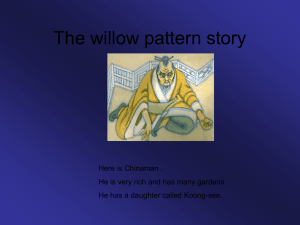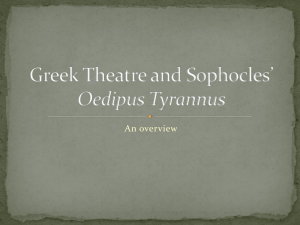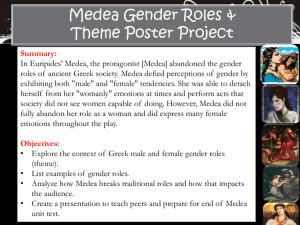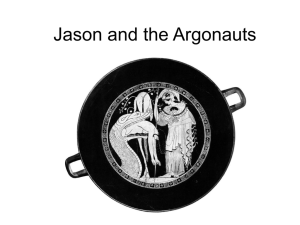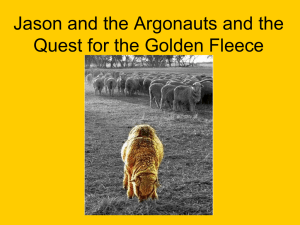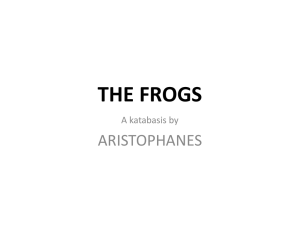Week 13-PPT
advertisement
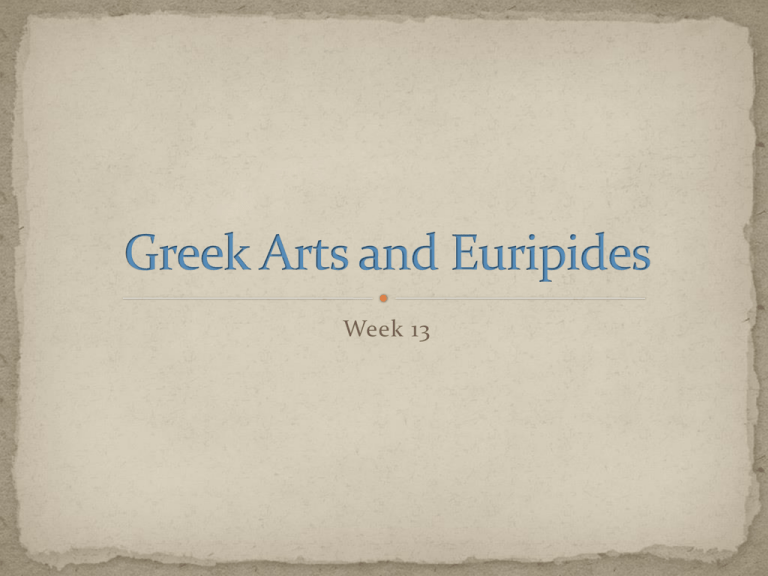
Week 13 33 questions [fill-in the blanks; from weekly journal, weekly quotes, and lecture notes (PPT) ] All in English (1)集結每周寫的小組討論與反思週記,可增加 自我反省本學期學習的歷程等。 (2)撰寫一篇短文,探討與倫理學或美學相關的 主題,可從本學期閱讀的文本和討論的題目中 再延伸發揮。(中文約2000字, 1000 words in English) (3)自由創作: 詩,散文,小說,漫畫,劇本…. (中英文皆可,自由發揮!) (4)合訂成小冊,編目錄。 希臘人富於民主思想和創造精神的天性,個性活潑開 放情,崇尚運動,追求自由自在的樂趣。因此藝術表 現上呈現出充滿健康、自然、樂觀、優雅等的特質, 而有別於近東藝術那種超自然的、宗教的神祕感。在 同一個時代,近東藝術中,作者只是奉命行事去完成, 作品中沒有個人的創意也不留名,可是到了希臘時代, 個人地位提昇,藝術品的製作者才逐漸受重視並留有 名字。 希臘人因其唯美、唯善觀及優美之地埋、氣候環境, 故追求完美,此種完美之要求亦及於人體及生活;再 因其有優美之氣候與環境,對於戶外活動亦極為熱衷, 於是有各種競賽、體能活動及奧林匹克運動會。 早期希臘雕刻受到埃及和近東各國的影響 直到「黑暗時代」過後,希臘人的雕刻開始 建立自己的風貌,展開蓬勃的發展,並對往 後歐洲藝術產生極大的影響。 希臘雕刻的風貌,主要靠文獻上的記載和羅 馬時代的仿製品而得知;由於年代久遠、歷 經戰亂和人為破壞,大部份原作己所剩無幾。 希臘的雕刻和 建築,是互為一體的,例如神廟建築上 的破風雕刻﹝山形牆雕刻﹞或浮雕飾 帶、墓碑上的浮 雕……等。 除了和建築相結合之外,獨立性的雕像也很可觀, 其 創作泉源來自「人體美」,是歷史上「裸體雕刻」的 創始。 http://vr.theatre.ntu.edu.tw/hlee/course/th9_ 1000/open-08-broadcast.htm 年代:450 B.C. 由器皿上的彩繪來看 ﹝一﹞幾何形風格(約 11OO ─ 7OO B.C.) ﹝二﹞東方風格(約 75O ─ 6OO B.C.) ﹝三﹞黑體人像繪畫(約 7OO ─ 5OO B.C.) ﹝四﹞紅體人像繪畫(約5OO B.C.) http://vr.theatre.ntu.edu.tw/hlee/course/th9_1000/open-08broadcast.htm 這是希臘本土構成性裝 飾的表現,在陶甕上畫 滿告種簡單而有規則的 幾何圖飾,這類型的作 品起初都沒有人物的裝 飾圖案,直到西元前第 八世紀才有明確的人物 形象出現。 早期的陶甕仍採用幾何圖案,由於當時希臘和近 東地區商務接觸而產生的風格,以故事作為描繪 的內容,人物、動物成為裝飾的主題,輪廓明確, 筆觸肯定,造型生動,作品尺寸隨之增大。 此種畫風存在於古樸時期至公元前六世紀末葉。以雕刻家 埃司克埃斯﹝Exekias﹞之作品,題為「埃加士與艾契列 士下棋」﹝Ajax & Achilles Playing Draughts﹞之陶罐 為例,其特色為表面光滑、人體皆為黑色、尖鼻大眼、布 局均衡、人物之腳部均在同一半畫面上、無景深,並有幾 何形圖案。在公元前六世紀末葉左右,希臘陶工與畫工在 社會中已漸有相當地位、故多在其作品上署名。 年代:540 B.C. 說明:黑體人像 繪畫 公元前五世紀左右,紅體人像繪畫逐漸取代黑體 人像繪畫。人物皆為紅色,所有人物之立足點已 非同在一水平線上,而係分布在並不規則之層次, 與重疊之人物共同產生遠近距離之感覺,同時各 人物皆有不同之動作,頗具動感。對人體之處理 方面,與黑人物畫風相較,較為活潑、寫實,而 非生硬、規律化。 Alice Y. Chang 15 Electrum is a naturally occurring alloy of gold and silver, with trace amounts of copper and other metals. It has also been produced artificially. The ancient Greeks called it 'gold' or 'white gold', as opposed to 'refined gold'. Its color ranges from pale to bright yellow, depending on the proportions of gold and silver. Silver Tetradrachm, with the Owl standing on a olive twig, a crescent on the upper left and "ΑΘΕ" in front and Athena wearing an ornamented helmet, 454 - 449 BC. 480-406 B.C. Alice Y. Chang 「舞台上的哲學家」的美稱 悲劇內容大多以家庭生活為題材,討論 戰爭、民主、貧富、宗教、婦女地位… 等問題 討論雅典奴隸民主制衰弱時期的社會思 想 寫實 現存十八部作品,是傳世作品最多的古 希臘悲劇家 Alice Y. Chang Alcestis Written 438 B.C.E Andromache Written 428-24 B.C.E The Bacchantes Written 410 B.C.E Hecuba Written 424 B.C.E Helen Written 412 B.C.E Translated by E. P. Coleridge The Heracleidae Written ca. 429 B.C.E Translated by E. P. Coleridge Alice Y. Chang Iphigenia At Aulis Written 410 B.C.E Rhesus Written 450 B.C.E Iphigenia in Tauris Written 414-412 B.C.E Translated by Robert Potter The Suppliants Written 422 B.C.E Translated by E. P. Coleridge Medea Written 431 B.C.E Translated by E. P. Coleridge The Trojan Women Written 415 B.C.E Alice Y. Chang an ancient Greek tragedy written by Euripides, based upon the myth of Jason and Medea and first produced in 431 BC. The plot centers on the barbarian protagonist as she finds her position in the Greek world threatened, and the revenge she takes against her husband Jason who has betrayed her for another woman. Alice Y. Chang A great healer, astrologer, and respected oracle, Chiron was said to be the last centaur and highly revered as a teacher and tutor. Among his pupils were many culture heroes: Asclepius, Theseus, Achilles, Jason, Peleus, Telamon, Heracles, Phoenix…. http://en.wikipedia.org/wiki/Chiron This is the title of a long poem, very popular in classical days, by the third-century poet Apollonius of Rhodes. He tells the whole story of the Quest except the part about Jason and Pelias which I have taken from Pindar. It is the subject of one of his most famous odes, written in the first half of the fifth century. Apollonius ends his poem with the return of the heroes to Greece. I have added the account of what Jason and Medea did there, taking it from the fifth-century tragic poet Euripides, who made it the subject of one of his best plays. The first hero in Europe who undertook a great journey was the leader of the Quest of the Golden Fleece. He was supposed to have lived a generation earlier than the most famous Greek traveler, the hero of the Odyssey. It was of course a journey by water. Ships did not sail by night, and any place where sailors put in might harbor a monster or a magician who could work more deadly harm No story proved this fact better than the account of what the heroes suffered who sailed in the ship Argo to find the Golden Fleece. It may be doubted, indeed, if there ever was a voyage on which sailors had to face so many and such varied dangers. However, they were all heroes of renown, some of them the greatest in Greece, and they were quite equal to their adventures. the Golden Fleece is the fleece of the gold- haired winged ram. It figures in the tale of Jason and his band of Argonauts, who set out on a quest for the fleece in order to place Jason rightfully on the throne of Iolcus in Thessaly. ancient region at the eastern end of the Black Sea south of the Caucasus, in the western part of modern Georgia In Greek mythology Colchis was the home of Medea and the destination of the Argonauts, a land of fabulous wealth and the domain of sorcery. the daughter of King Aeëtes of Colchis, niece of Circe, granddaughter of the sun god Helios, and later wife to the hero Jason, with whom she had two children: Mermeros and Pheres. In Euripides's play Medea, Jason leaves Medea when Creon, king of Corinth, offers him his daughter, Creusa or Glauce. The play tells of how Medea gets her revenge on her husband for this betrayal. Medea figures in the myth of Jason and the Argonauts Medea is known in most stories as an enchantress and is often depicted as being a priestess of the goddess Hecate or a witch. The myth of Jason and Medea is very old, originally written around the time Hesiod wrote the Theogony. –noun, plural -ras. 1.(often initial capital letter ) a mythological, fire-breathing monster, commonly represented with a lion's head, a goat's body, and a serpent's tail. 2.any similarly grotesque monster having disparate parts, esp. as depicted in decorative art.3.a horrible or unreal creature of the imagination; a vain or idle fancy: He is far different from the chimera your fears have made of him. 4.Genetics. an organism composed of two or more genetically distinct tissues, as an organism that is partly male and partly female, or an artificially produced individual having tissues of several species. Week 15 Alic e Y. Most of these plays date from the last half of the fifth century B.C.; they were written in and for an Athens that, since the days of Aeschylus, had undergone an intellectual revolution. It was in a time of critical reevaluation of accepted standards and traditions that Sophocles produced his masterpiece, Oedipus the King, and the problems of the time are reflected in the play. Alice Y. Chang The use of the familiar myth enabled the dramatist to draw on all its wealth of unformulated meaning, but it did not prevent him from striking a contemporary note. Oedipus, in Sophocles’ play, is at one and the same time the mysterious figure of the past who broke the most fundamental human taboos and a typical fifthcentury Athenian. His character contains all the virtues for which the Athenians were famous and the vices for which they were notorious. Alice Y. Chang Alice Y. Chang Euripides’ Medea, produced in 431 B.C., the year that brought the beginning of the Peloponnesian War, appeared earlier than Sophocles’ Oedipus the King, but it has a bitterness that is more in keeping with the spirit of a later age. Alice Y. Chang Alice Y. Chang Alice Y. Chang NURSE Oh how I wish that ship the Argo had never sailed off to the land of Colchis, past the Symplegades, those dark dancing rocks which smash boats sailing through the Hellespont. I wish they'd never chopped the pine trees down in those mountain forests up on Pelion, to make oars for the hands of those great men who set off, on Pelias' orders, to fetch the golden fleece. Alice Y. Chang Then my mistress, Medea, never would've sailed away to the towers in the land of Iolcus, her heart passionately in love with Jason. She'd never have convinced those women, Pelias' daughters, to kill their father. She'd not have come to live in Corinth here, with her husband and her children—well loved in exile by those whose land she'd moved to. She gave all sorts of help to Jason. Alice Y. Chang This I know is true. Of all things with life and understanding, we women are the most unfortunate. I have no city, and I'm being abused by my own husband. I was carried off, a trophy from a barbarian country. I have no mother, brother, or relation, to shelter with in this extremity. When Jason and Medea returned to Iolcus, Pelias still refused to give up his throne. Medea conspired to have Pelias' own daughters kill him. She told them she could turn an old ram into a young ram by cutting up the old ram and boiling it (alternatively, she did this with Aeson, Jason's father). During the demonstration, a live, young ram jumped out of the pot. Excited, the girls cut their father into pieces and threw him into a pot. Having killed Pelias, Jason and Medea fled to Corinth. Alice Y. Chang Alice Y. Chang Alice Y. Chang Alice Y. Chang 米蒂亞是科奇斯島國的公主,也是女祭師,一生命運 乖舛,她愛上來自外地為了取得金羊毛與她父親作對 的傑遜王子,不過,這段姻緣最後卻以悲劇收場。 米蒂亞是月亮女神的乾女兒,所以她懂得使用許多的 黑魔法,她會調製靈藥、占卜、下毒。 不但法術高強也非常聰明與殘忍,他曾為了傑遜,親 手殺了他自己的弟弟。後因為傑遜移情別戀,與鄰國 的公主結婚,被情人拋棄的米蒂亞一怒之下,製作了 一件沾滿毒藥的禮服,送給傑遜的未婚妻,將其殺 害。甚至還親手殺了自己為傑遜生下的兩名稚子,最 後騎著馬離開傷心地。 Alice Y. Chang In Corinth, Jason abandoned Medea for the king's daughter, Glauce. Medea took her revenge by sending Glauce a dress and golden coronet, covered in poison. This resulted in the deaths of both the princess and the king, Creon, when he went to save her. Alice Y. Chang According to the tragic poet Euripides, Medea continued her revenge, murdering her two children by Jason. Afterward, she left Corinth and flew to Athens in a golden chariot driven by dragons sent by her grandfather Helios, god of the sun. Alice Y. Chang Alice Y. Chang The common background of audience and poet is disappearing, the old certainties are being undermined, the city divided. Euripides is the first Greek poet to suffer the fate of so many of the great modern writers: rejected by most of his contemporaries (he rarely won first prize and was the favorite target for the scurrilous humor of the comic poets), he was universally admired and revered by the Greeks of the centuries that followed his death. Alice Y. Chang It is significant that what little biographical information we have for Euripides makes no mention of military service or political office; unlike Aeschylus, who fought in the ranks at Marathon, and Sophocles, who took an active part in public affairs from youth to advanced old age, Euripides seems to have lived a private, an intellectual life. Alice Y. Chang Younger than Sophocles ( though they died in the same year), he was more receptive to the critical theories and the rhetorical techniques offered by the Sophist teachers; his plays often subject received ideas to fundamental questioning, expressed in vivid dramatic debate. Alice Y. Chang His Medea is typical of his iconoclastic approach; his choice of subject and central characters is in itself a challenge to established canons. He still dramatizes myth, but the myth he chooses is exotic and disturbing, and the protagonist is not a man but a woman. Alice Y. Chang Medea is both woman and foreigner—that is, in terms of the audience’s prejudice and practice she is a representative of the two free-born groups in Athenian society that had almost no rights at all (though the male foreign resident had more rights than the native woman). Alice Y. Chang The tragic hero is no longer a king, “one who is highly renowned and prosperous such as Oedipus,” but a woman who, because she finds no redress for her wrongs in society, is driven by her passion to violate that society’s most sacred laws in a rebellion against its typical representative, Jason, her husband. Alice Y. Chang All through Medea the human beings involved call on the gods; two especially are singled out for attention: Earth and Sun. It is by these two gods that Medea makes Aegeus swear to give her refuge in Athens, the chorus invokes them to prevent Medea’s violence against her sons, and Jason wonders how Medea can look on Earth and Sun after she has killed her own children. Alice Y. Chang These emphatic appeals clearly raise the question of the attitude of the gods, and the answer to the question is a shock. We are not told what Earth does, but Sun sends the magic chariot on which Medea makes her escape. Alice Y. Chang Euripides is the first Greek poet to suffer the fate of so many of the great modern writers: rejected by most of his contemporaries (he rarely won first prize and was the favorite target for the scurrilous humor of the comic poets), he was universally admired and revered by the Greeks of the centuries that followed his death. Alice Y. Chang His Medea is typical of his iconoclastic approach; his choice of subject and central characters is in itself a challenge to established canons. He still dramatizes myth, but the myth he chooses is exotic and disturbing, and the protagonist is not a man but a woman. Medea is both woman and foreigner, that is, in terms of the audience’s prejudice and practice she is a representative of the two free-born groups in Athenian society that had almost no rights at all (though the male foreign resident had more rights than the native woman). Alice Y. Chang She is not just a woman and a foreigner, she is also a person of great intellectual power. Compared with her the credulous king and her complacent husband are children, and once her mind is made up, she moves them like pawns to their proper places in her barbaric game. The myth is used for new purposes, to shock the members of the audience, attack their deepest prejudices, and shake them out of their complacent pride in the superiority of Greek masculinity. Alice Y. Chang The tragic hero is no longer a king, “one who is highly renowned and prosperous such as Oedipus,” but a woman who, because she finds no redress for her wrongs in society, is driven by her passion to violate that society’s most sacred laws in a rebellion against its typical representative, Jason, her husband. Alice Y. Chang 美狄亞,或譯米蒂亞,是古往今來最著名的復仇女性,也是所 有受背叛、嫉妒所苦的女性的守護神。爲了愛上一個外邦人傑 森,她抛卻公主地位、竊走國寶金羊毛、殺死弟弟,甘願隨夫 遠走他鄉、漂泊失所。然而她的勇敢愛情和偉大犧牲最終卻變 成一則笑話:丈夫決定另娶柯林斯公主,換取穩定名位。美狄 亞走投無路之下,展開恐怖報復:先是獻毒衣焚殺丈夫的新 歡,繼而手刃兩個小孩,乘太陽神的華車遠颺,留下一無所 有的負心丈夫。 Alice Y. Chang [shouting into the house, as he shakes the doors] You slaves in there, remove the bar from this door at once, withdraw the bolts, so I may see two things— my dead sons and their murderer, that woman on whom I shall exact revenge. Alice Y. Chang Jason shakes the doors of the house, which remain closed. Medea appears in a winged chariot, rising above the house. The bodies of the two children are visible in the chariot] Alice Y. Chang Why are you rattling the doors like that, trying to unbar them so you can find their bodies and me, the one who killed them? Stop trying. If you want something from me, then say so, if you want to. But you'll never have me in your grasp, not in this chariot, a gift to me from my grandfather Helios, Alice Y. Chang Zeus on Olympus, dispenses many things. Gods often contradict our fondest expectations. What we anticipate does not come to pass. What we don't expect some god finds a way to make it happen. So with this story. Alice Y. Chang Alice Y. Chang 1. 評論與詮釋Medea的結尾, Chorus 的總結。 2. Creative work: Write a poem or speech to comfort Medea.
